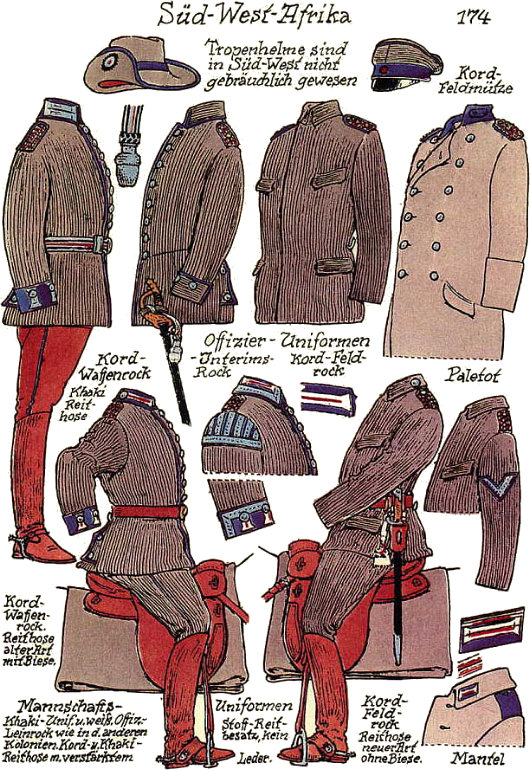Military
About Andrew Cusack
 Writer, web designer, etc.; born in New York; educated in Argentina, Scotland, and South Africa; now based in London.
Writer, web designer, etc.; born in New York; educated in Argentina, Scotland, and South Africa; now based in London. read more
News
Blogs
Reviews & Periodicals
Arts & Design
World
France
Mitteleuropa
Knickerbockers
Argentina
The Levant
Africa
Cape of Good Hope
Netherlands
Scandinavia
Québec
India
Muscovy
Germany
Academica
Interview with the Last July 20 Plotter
Der Speigel speaks with 88-year-old Ewald von Kleist
Ewald von Kleist is the last surviving member of the circle of Wehrmacht officers who participated in the July 20, 1944 plot to kill Hitler and overthrow the Nazi state. Der Spiegel has translated its interview with him into English, and all four pages feature interesting insights from this brave old man.
And if you read German (I don’t), you might be interested in this article on China & Carl Schmitt.
The Drakensberg in Buenos Aires
An Argentine-South African Naval Encounter
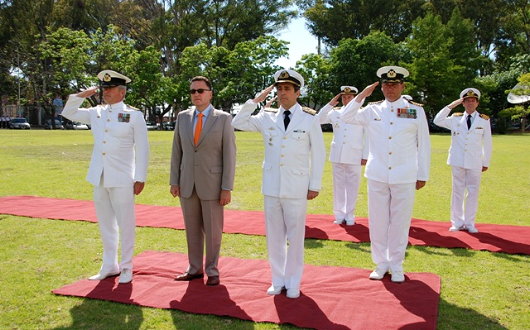
The South African Ship Drakensberg sailed into Buenos Aires last month as part of the sea phase of ATLASUR VIII, a naval exercise involving ships from Argentina, Uruguay, Brazil, and South Africa. Mr Tony Leon, former Leader of the Opposition and currently South African Ambassador to Argentina, was picked up by the ship-borne Oryx helicopter and landed on Drakensberg to observe the sail into Buenos Aires’s harbour. Mr Leon served in the SAN aboard President Pretorius in 1976. (more…)
Remembrance 2010
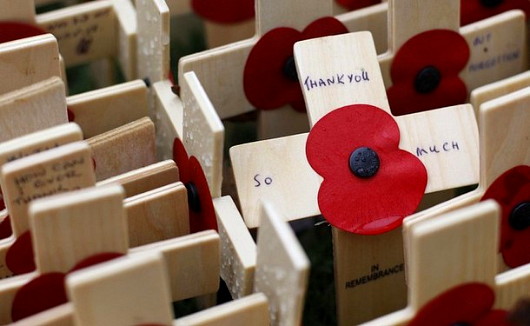
IN A WORLD utterly deprived of solemnity, Remembrance Day (and Remembrance Sunday) provides one of the few opportunities for silence, reflection, and appreciation. The First World War was truly a war without victory, the war that Europe lost. Its end is marked not with marching bands proclaiming triumph but with two minutes’ silence. How appropriate that the guns of the Great War finally fell silent on Martinmas day, the feast of the patron saint of soldiers, in this gloomy time of year. On this day there is no triumph nor victory, no vain pomp and glory of this world, but instead a deep respect for the awesome sacrifice of the fallen — a respect whose only expression can be found in that silence. (more…)
The Festival of Remembrance
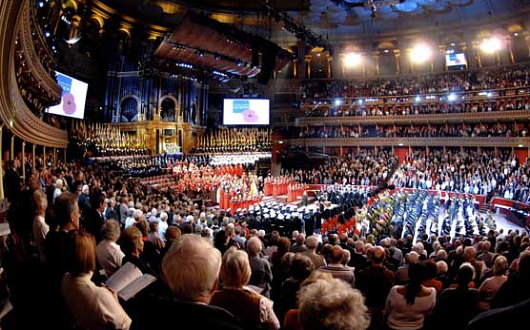
The Royal British Legion, the organisation which supports Britain’s veterans, organises the annual Festival of Remembrance at the Royal Albert Hall in London. The first half of the event is part military tattoo, part popular concert, but the second half is a Christian service of remembrance for the dead of all wars. The Festival takes place the Saturday before Remembrance Sunday: a 2:00pm matinee for the general public, and a 7:00pm one for veterans, servicemen, and their families in the presence of the Royal Family. The 7:00pm festival is broadcast on BBC1 every year, but sadly is not yet simulcast via internet for those abroad. Here are a few YouTube clips from different parts of the service in the past two years. (more…)
Mexico’s Military Parade
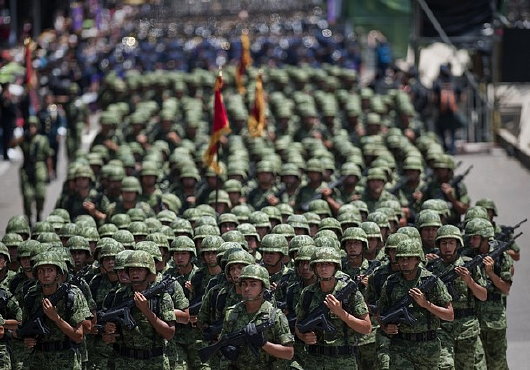
SIX-HUNDRED TROOPS, seventeen countries, field dress, full dress, and everything in between: the military parade to mark Mexico’s bicentennial was a remarkable sight to see. The parade moved down the Paseo de la Reforma, originally the Paseo de la Emperatriz, or Promenade of the Empress. The seven-and-a-half-mile-long boulevard was built on the orders of Maximilian I, Emperor of Mexico and was modelled after the Champs-Élysées in Paris and the Ringstrasse in Vienna. It stretches from the Zócalo square at the center of the city (where the Cathedral and National Palace are) to the Chapultepec Castle, the imperial residence during the Second Mexican Empire. (more…)
A Festive Flotilla
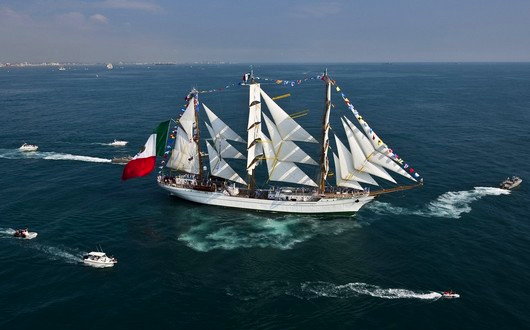
A great flotilla of tall ships from twelve countries set sail from Rio de Janiero on February 7th of this year for a months-long regatta to commemorate the bicentennial year of Mexico, Chile, and other Latin American countries. After departing Rio, “Sails of South America 2010” called in at Buenos Aires, Ushuaia, Punta Arenas, Valparaíso, and other points before finishing in Veracruz, Mexico in time for the commencement of the Mexican bicentennial in September.
ARM Cuauhtémoc (above), the training ship of the Mexican Navy, is a steel-hulled barque built in Bilbao in 1982. (more…)
The Blitz was Wrong
In his latest column for the Mail on Sunday, the commentator and Orwell Prize winner Peter Hitchens shares his thoughts on the Blitz — the Luftwaffe’s bombing campaign over London that commenced sixty years ago this month. His comments have special relevance given the previous posts on andrewcusack.com regarding the immorality of the Hiroshima & Nagasaki bombings, and likewise of the intentional and deliberate targeting of civilian non-combatants. (more…)
Douglas Murray: In Order to Prevent the Use of WMDs, We Must Use WMDs
The slightly camp Old Etonian atheist neo-con Douglas Murray got himself into a bit of trouble recently when he and Baroness Deech unleashed a splenetic rant against Scotland and the Scots on BBC Radio 4. As head of the HFEA, Baroness Deech presided over the deaths of an untold number of humans in the embryonic stage of development, but it turns out that Mr. Murray (who is Scottish-born, curiously) has advocated hypothetical wholesale slaughter.
In 2007, Mr. Murray helped compose Towards a Grand Strategy for an Uncertain World: Renewing Transatlantic Partnership ostensibly written by Gen. Dr. Klaus Naumann (former Bundeswehr Chief of Staff), Gen. Prince John Salikashvili (Georgian prince and former U.S. Chairman of the Joint Chiefs of Staff), Field Marshal the Lord Inge (former U.K. Chief of the General Staff), Adm. Jacques Lanxade (former Chief of the French Navy), and Gen. Henk van den Breemen (accomplished organist and former Chief of Staff of the Dutch military).
This interesting document made a number of recommendations, the most intriguing of which is the suggestion that NATO should be prepared to make a pre-emptive nuclear strike… in order to prevent the use of weapons of mass destruction (“WMDs”) such as, er, nuclear weapons. You read that correctly: in order to prevent the use of WMDs, NATO should be prepared to use WMDs. You couldn’t make it up!
Three for the Army
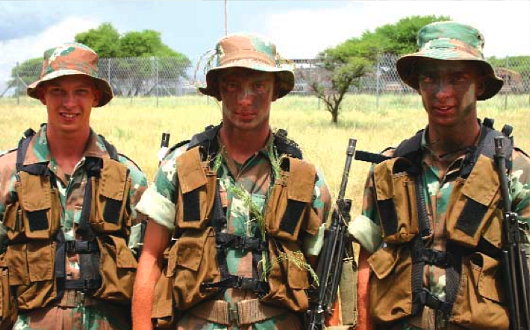
Something you don’t see every day: a set of triplets from Pretoria recently completed basic training as part of their enlistment in the South African Army. Dirk van Zyl, Tjaart van Zyl, and Hendrik van Zyl (above, left-to-right) are 20 years old and got their mechanical engineering qualifications before enlisting in the Defence Force.
The three brothers are all part of Foxtrot Company, 3 South African Infantry Battalion based at Kimberley in the Northern Cape; Hendrik in Platoon 1, Tjaart in Platoon 2, and Dirk in Platoon 3.
Large-scale operational deployments of the South African military have been few and far between since the country withdrew from the Angolan conflict and granted Namibia independence. Since then they have mostly consisted of United Nations and African Union peacekeeping operations, as well as other endeavours such as South Africa’s 1998 military intervention in a dynastic dispute in the neighbouring Catholic monarchy of Lesotho. Current defence regulations prevent siblings like the van Zyl brothers from being operationally deployed simultaneously.
Clarity on Torture
Those who see abortion as an evil are often frustrated by those who attempt to justify abortion by vague arguments about “choice” or even more practical arguments about exceptions for rape or incest, or the health of the mother. But many of these same people lose their moral clarity when the subject is torture. Suddenly they are the ones bringing up exceptions and parsing definitions.
There is so much confusion over this issue that in a recent TV interview, a prominent Catholic journalist let a former Bush Administration speechwriter, also a Catholic, grossly misrepresent Catholic teaching in a shameful apologia for torture.
Let us re-establish clarity. Torture, whether physical or psychological, is a barbaric, savage act, not justifiable under any circumstances, and unworthy of a civilized society.
But don’t take our word for it. For those readers who are religious, the Evangelical Lutheran Church in America began calling for America to cease torturing prisoners more than a year ago. American Episcopal bishops agree, as do other Protestant denominations. For our Catholic readers, Pope Benedict XVI wrote, “I reiterate that the prohibition against torture cannot be contravened under any circumstances.” The Catholic Church draws no distinction between physical and psychological torture.
For those readers who aren’t religious, we turn to U.S. law and international law, where torture is, without exception, condemned. Not one state or municipal law enforcement agency permits it. The Army Field Manual, which regulates interrogations by the U.S. military, prohibits torture. So does the Geneva Convention—a treaty to which both the Holy See and the United States are signatories. None of these institutions or documents draws any distinction between physical and psychological torture either. For all, torture is torture.
When Catholics and Protestants agree, and when religious and secular institutions agree, that torture is an offense against human dignity and that those guilty of it should be thrown in jail, may we not agree that perhaps it is immoral? Do we really need to get into the nuts and bolts of what constitutes torture?
Yes, we do. Most will agree that taking a power drill to a man’s shoulder or pulling out his fingernails with pliers for punishment or to extract information is torture. But when the subject is waterboarding, clarity vanishes again. Some consider waterboarding to be mere psychological torture—which, as we’ve already established, is morally indistinguishable from physical torture.
But waterboarding is not a harmless dunk in the tub, as former Vice President Dick Cheney once likened it, and it is not psychological torture. In waterboarding, a subject is strapped to a gurney. His feet are elevated slightly above his head. A cloth is draped over his face. And water is poured on his face so that it enters his nose and mouth and flows into his lungs. CIA interrogators are instructed to pour the water immediately after a detainee exhales, to ensure he inhales water, not air. They use their hands to “dam the flow” of excess water from a detainee’s mouth. And detainees who are scheduled for waterboarding are put on a liquid diet, to minimize the risk of death should they inhale their own vomit.
This procedure became official American policy in our so-called War on Terror, but it was not always so. Waterboarding has been condemned by the United States government since at least 1898, when American soldiers were court marshaled for waterboarding prisoners during our occupation of the Philippines following the Spanish-American War. In World War II, we hanged Japanese war criminals for waterboarding American and Allied troops. In the 1980s in Texas, a sheriff and three of his deputies were convicted by the Justice Department for waterboarding prisoners to extract confessions.
And yet, there are those exceptions: American security is at stake. If waterboarding saves even one life, isn’t it worth it?
If torturing a terrorist suspect saved a city from destruction, or if it saved even one life, it would still be a barbaric, savage act, unworthy of a civilized society. If expediency were enough to justify an immoral act, then abortion would be justifiable.
G.K. Chesterton wrote in 1916 that people who purport to defend civilization against barbarians undermine their cause when they resort to barbaric tactics. “The more we insist that the terms must be our terms, the more do we weaken ourselves if the methods are their methods.”
During World War I, when some in England demanded that German soldiers captured on English soil be denied humane treatment, Chesterton countered, “Such small revenges are unworthy of the dignity of indignation. They are also futile and inconsequent.”
Our whole hope of getting a monster killed and not scotched depends upon our keeping fresh the original human horror at its monstrosity. It may be illogical, but it will certainly be natural, if that horror is somewhat dulled if, by the end of the war, everybody seems to be fighting with pretty much the same weapons.
When you torture, you turn the victim into a hero, for there is more honor in defying a torturer than in being a torturer.
“A kind of courage can exist in a merciless and unmagnaminous soldier, as it can exist in a merciless and unmagnaminous wild pig,” Chesterton wrote. “But it does not happen to be the kind of courage that our brethren have died to keep alive.”
It helps to be a 92-year-old D-Day veteran
Daniel Hannan, the whiggish MEP representing South East England, relays a story about His Excellency Philip Hannan, the 92-year-old former Archbishop of New Orleans:
When Hurricane Katrina wrecked the city, the old prelate went to the diocesan office to help. He found his successor wracked with concern about the fate of a parish priest who was lost in the storm. Seeing that anxiety had left the poor man paralysed, my 92-year-old kinsman called the military authorities.
“This is Phil Hannan. I jumped with the 82nd Airborne at Normandy. I need a helicopter”.
A helicopter duly arrived, and carried the former army padre to the home of the missing cleric, which had been turned to matchwood. Returning to the archiepiscopal residence, Hannan announced without ceremony, “He’s dead, may he rest in peace. Let’s move on to the next problem”.
Victory+65 in Moscow
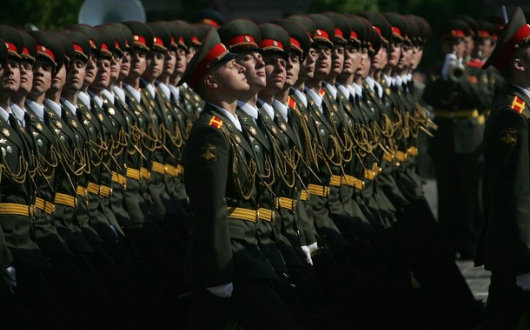
ANOTHER VICTORY DAY in Moscow — sixty-five years now since the Allied Powers defeated the crisply attired Axis of Nazi Germany and her slightly foppish cohort Fascist Italy. Russia commemorates V-E Day a day “late” because the German instrument of surrender entered into force at 23:01 CET on May 8, 1945 — by which time it was already May 9 in Moscow. For this reason most countries within the ex-Soviet sphere celebrate the end of the Second World War a day later than in western Europe. It is also customary on this day for patriotic citizens to wear the orange-and-black ‘Ribbon of St. George’, which recalls the Military Order of the Holy Great-Martyr and the Triumphant George established in 1769 and revived in 1994. The Order of St. George is the highest military honour awarded by Russia after the paramount Order of St. Andrew. (more…)
A Collector’s Apartment
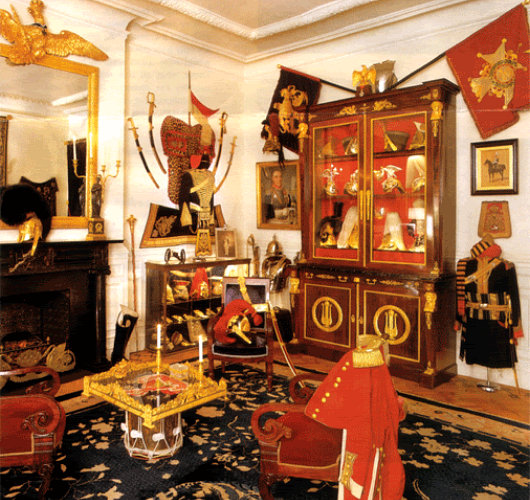
These photos come from an issue of Architectural Digest from the 1980s that some chap scanned and put online. The article that these pictures accompanied was about the New York apartment of a collector specialising in military items, but unfortunately the scanner did not post any further information. (more…)
Engelsman se Graf

It was just a dot and a name on the map on our way to Wupperthal — Englishman’s Grave, “Hmmm… I wonder what that could be”. The Cederberg mountains have many charms, and of course any one who drinks as much rooibos tea as I must be intrigued to see the only place in the world where it is commercially grown. Leopards, caracals, and bonteboks guard these hills, and of course our friend the dassie (previously seen here) is known to wander around its rocks. (more…)
The Blue Hussars
Ireland’s Mounted Presidential Escort
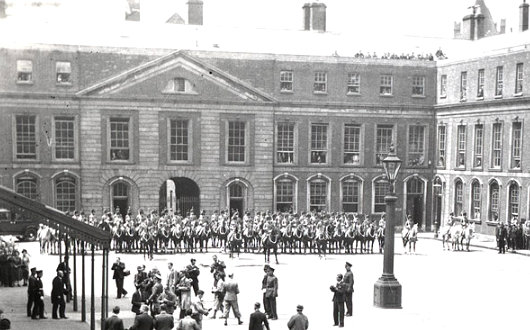
 WHEN BRITAIN FINALLY granted dominion status to Ireland, her longest-held possession, in the 1920s it unfortunately also signalled the end to a long tradition of Irish service in H.M. Forces. Well, this is not entirely true — thousands of Irishmen from both Ulster and the Republic continue to volunteer for the Army, Royal Navy, and RAF (the Royal Irish Regiment and the Irish Guards receiving the lion’s share) with an exemplary record of service to the Crown. But numerous other regiments with long lineages rolled up their colours in a dramatic ceremony at Windsor Castle in 1922. (An aside: one of those five regiments was the Connaught Rangers whose former name — the 88th Regiment of Foot — inspired the later re-designation of a New York Guard unit as the 88th Brigade NYG, of which yours truly is a veteran and my uncle the former commander).
WHEN BRITAIN FINALLY granted dominion status to Ireland, her longest-held possession, in the 1920s it unfortunately also signalled the end to a long tradition of Irish service in H.M. Forces. Well, this is not entirely true — thousands of Irishmen from both Ulster and the Republic continue to volunteer for the Army, Royal Navy, and RAF (the Royal Irish Regiment and the Irish Guards receiving the lion’s share) with an exemplary record of service to the Crown. But numerous other regiments with long lineages rolled up their colours in a dramatic ceremony at Windsor Castle in 1922. (An aside: one of those five regiments was the Connaught Rangers whose former name — the 88th Regiment of Foot — inspired the later re-designation of a New York Guard unit as the 88th Brigade NYG, of which yours truly is a veteran and my uncle the former commander).
The forces which became the Irish Free State Army, given their irregular nature, lacked a ceremonial tradition (though, had I been around and Michael Collins invited me to do so, I would’ve happily manned the desk in the IRA Office of Protocol, Ceremony, and Feathery Hats). In 1932, Dublin hosted the International Eucharistic Congress — a big event in those days, sadly reduced in stature — which meant that dignitaries of great importance would take this opportunity to visit the Irish capital. (more…)
When an American aristocrat meets a European Grand Duke
Mother Margaret Georgina Patton, OSB of Regina Laudis Abbey in New England is the daughter of Gen. George S. Patton IV and granddaughter of the famous Gen. George S. Patton III. Mother Patton remembers being introduced to the Grand Duke of Luxembourg when she was but five years of age. At the instruction of her parents, she spent a week practicing her curtsey. When the moment finally came and she was brought before His Royal Highness, she looked him over, and stuck out her hand. The young girl had expected a crown, and, seeing none, thought a regular old handshake would do.
The elder Gen. Patton did have a connection to the Abbey himself. “General George Patton, Sr., liberated France as the commanding general of the Third Army,” explains Mother Delores Hart (the former film actress, and only nun among the members of the Academy of Motion Picture Arts & Sciences). “His was the army that liberated Jouarre, the abbey where Mother Benedict was in hiding.” Mother Benedict Duss founded the Abbey of Regina Laudis after the war, and died at the ripe age of 94.
“This connection continues through the whole Patton family to this day,” Mother Delores continued. George S. Patton V lives close to the Abbey in Connecticut, with his brothers Robert H. Patton in nearby Darien, and Benjamin Wilson Patton in New York, while their sister Helen lives in Saarbrücken, Germany.
General Patton père died in a car accident in Germany, but his son followed in his footsteps by choosing a career in the army. When his daughter Margaret, the future nun, was born, he was fighting in the wilds of Vietnam. Nonetheless, General Patton fils felt compelled to write a letter to his newborn daughter, introducing himself from abroad. He ended it simply “Play it cool” and signed his full name.
It’s no wonder that Margaret joined Regina Laudis, a community of Benedictines in full, traditional habits, as she came from a well-dressed family. General Patton père designed his own uniforms and even the family of the younger general continued the tradition of dressing for dinner, “despite the trend toward informality that was sweeping the nation” as the Patton Saber puts it. The old habits are returning — any bets on when folks will start dressing for dinner again?
St. Nicholas of the Seven Seas
 ONE OF OUR correspondents sends word that Russia is to name the fourth of her Borei-class ballistic missile submarines Николай Чудотворец, which is to say “Saint Nicholas”. The Borei-class vessels are the first series of Russian strategic submarines to be launched in the post-Soviet era. The previous subs in the class have been named the Yuri Dolgoruki (after Prince Yuri I, founder of Moscow), the Alexander Nevsky (after the Grand Prince of Vladimir & Novgorod venerated as a saint in the Eastern churches), and the Vladimir Monomakh (after the Grand Prince of Kievan Rus). The Saint Nicholas is of course not the first boat or ship to bear the name of New York’s patron saint. There was HMS St. Nicholas as well as a Spanish naval ship San Nicolas in the 1790s, eventually captured by the Royal Navy and commissioned as HMS San Nicolas. A Sealink (later Stena) ferry named St. Nicholas traversed the Harwich/Hook-of-Holland route from 1983 until it was renamed Stena Normandy in 1991 and transferred to the Southampton/Cherbourg route. Numerous merchant vessels took the saint’s name and patronage throughout the nineteenth century.
ONE OF OUR correspondents sends word that Russia is to name the fourth of her Borei-class ballistic missile submarines Николай Чудотворец, which is to say “Saint Nicholas”. The Borei-class vessels are the first series of Russian strategic submarines to be launched in the post-Soviet era. The previous subs in the class have been named the Yuri Dolgoruki (after Prince Yuri I, founder of Moscow), the Alexander Nevsky (after the Grand Prince of Vladimir & Novgorod venerated as a saint in the Eastern churches), and the Vladimir Monomakh (after the Grand Prince of Kievan Rus). The Saint Nicholas is of course not the first boat or ship to bear the name of New York’s patron saint. There was HMS St. Nicholas as well as a Spanish naval ship San Nicolas in the 1790s, eventually captured by the Royal Navy and commissioned as HMS San Nicolas. A Sealink (later Stena) ferry named St. Nicholas traversed the Harwich/Hook-of-Holland route from 1983 until it was renamed Stena Normandy in 1991 and transferred to the Southampton/Cherbourg route. Numerous merchant vessels took the saint’s name and patronage throughout the nineteenth century.
The Union Defence Force
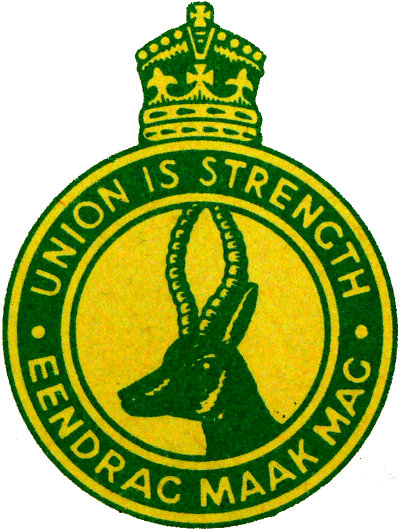
From 1912 to 1957, South Africa’s military was called the Union Defence Force (the Union in question being the Union of South Africa, the other USA). The Nationalist government renamed it the South African Defence Force (Suid-Afrikaanse Weermag) in 1957, prior to the declaration of the Republic of South Africa in 1961. After the introduction of universal suffrage in 1994, the SADF was merged with the MK (Umkhonto we Sizwe, the ANC’s terror branch) and APLA (Azanian People’s Liberation Army, the terrorist wing of the Pan-Africanist Congress), as well as the Self-Protection Units of Prince Mangosuthu Buthelezi’s Inkatha Freedom Party, into the South African National Defense Force (SANDF, or SANDEF), which remains the name of the country’s armed forces today.
The Band-leader & the Sergeant-Major
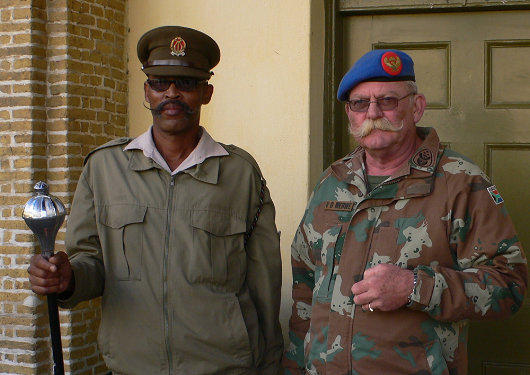
I came across these two characters in the Castle in Cape Town, the oldest building in South Africa and still home to the Cape Town Highlanders and Cape Garrison Artillery.
Search
Instagram: @andcusack
Click here for my Instagram photos.Most Recent Posts
- Burns Tower April 19, 2024
- Patrick in Parliament March 18, 2024
- Articles of Note: 13 March 2024 March 13, 2024
- Cambridge March 9, 2024
- Taken on Trust March 4, 2024
Most Recent Comments
Book Wishlist
Monthly Archives
Categories

